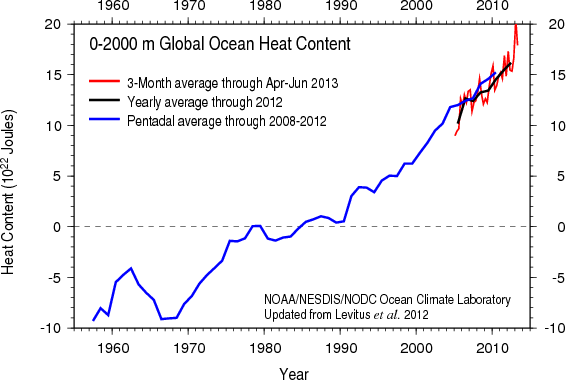It's a La Nina Year. So Why Isn't It Really, Really Cold?

Cross-posted from Informed Comment.
2013 is witnessing another year of very low sunspot activity, showing that we are in a years-long solar minimum. It may not last much longer, but something is going on more than just the usual drop in solar activity every 11 years. Even that 11-year cycle affects the weather. But we’ve seen remarkably low sunspot activity for several years now, with 2009 being especially quiet. We are probably at the bottom of the 100-year Gleissberg Cycle, and the limited sunspot activity could last for another 10 years or so.
In history, if you have several years in a row of low sunspot activity, it can affect the climate (it makes it colder). If you have a really long period of few sunspots, as with the Maunder Minimum of 1645-1715, many scientists and historians believe it can produce freezing temperatures. (there is no evidence that we are entering another Maunder Minimum, contrary to what some sensationalists have suggested).
Although we historians don’t want to hang everything on one explanation such as climate, climate does have a big impact on history. The Little Ice Age 1250-1850 is thought to be implicated in big changes like the turn to potato cultivation when local European crops failed because of the cool temperatures and the import from the New World thrived better. Big social conflicts such as the Thirty Years’ War and the French Revolution were also driven in part by climate stresses on agriculture and consequent bread shortages. Those denialists who write in to tell me that as a historian I ought not to be pronouncing on climate issues do not know very much about contemporary historical methods.
We need a lot of work to prove it, but the Maunder Minimum coincides with the fall of the Safavid Empire (1502-1722) of Iran and the great Mughals (1526-1707) in India, and these events may have been driven in part by climate change. Climate change has different impacts on different parts of the world, but these were agrarian empires and colder weather inevitably affects crops. It could be that the lack of sunspots in the Maunder Minimum worked to much reduce crop yields in Iran and India and so to impoverish the Safavids and Mughals, weakening them and making them ripe for challenge by pastoralists (the Afghan tribes that excel in using marginal land to raise livestock overthrew the Safavids, and the Mughals were challenged by the mobile Marathas and later the Afghans).
So if we are at the bottom of the hundred-year Gleissberg cycle with few sunspots for years, it should be really, really cold, right?
Then, there is the cyclical but somewhat unpredictable El Nino/ La Nina phenomenon in the center-east Pacific Ocean. There have been an unusual number of cool La Ninas in the past 15 years.
So it should be really, really cold, right? Back to back La Ninas, plus a Gleissberg solar minimum.
Then, it turns out that the upper waters of the world’s oceans are warming up faster than in the past. The oceans are very deep and very cold, and take a long time to warm and to circulate the heat. But even they are noticeably heating up. Some parts of the ocean, such as the Greenland Sea, are heating up 10 times faster than the rest of the ocean. So much that it is like a Hiroshima atomic bomb going off every second for thirty years in a row. If the oceans are absorbing a lot of the extra heat produced by greenhouse gases trapping the sun’s energy on earth, then the atmosphere would not have to warm as much.

So it should be really, really, really cold.
But it isn’t cold. Warming has continued during the past decade and a half. Sophie Lewis writes, “The last decade was the hottest on record globally. Each year from 2000 to 2010, except 2008, was in the 10 warmest recorded globally.”
That conclusion is terrifying. We should be shivering. We’re sweltering. All the solar minimum and the La Ninas and the displacement of warming to the seas have been able to do is slightly slow the rate in the warming of surface temperatures. If we’d had normal sunspot activity and lots of El Ninos and if the oceans hadn’t started taking on some of the extra heat, the thermometers would be bursting the way they do in a Roadrunner cartoon.
The world has already warmed by 1 degree C. in the past century, and we are locking ourselves into a 2-4 degrees C. rise in this century. (Hint: a 4 degrees C. increase might well make the climate unstable and endanger human survival).
The paid-for denialists who will try to tell you that global warming has stopped and we don’t need to get off oil, gas and coal tout de suite are snowing you. And they are drowning your grandchildren as sure as if they were pushing their heads under the waves and holding them there while the little ones thrash and their eyes bulge and their lungs fill with water. All to make another buck off their dirty fuel. If you have a house and you haven’t had it properly insulated and haven’t made an appointment to put solar panels on it, you aren’t helping save humankind.
Related Links